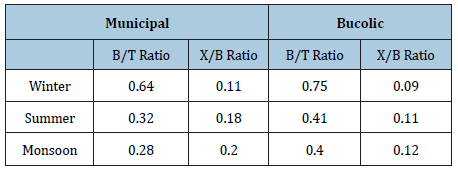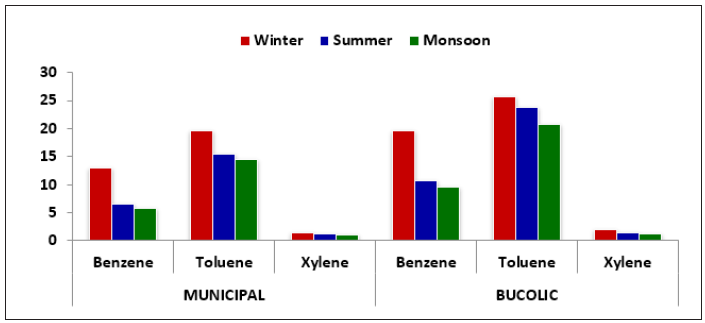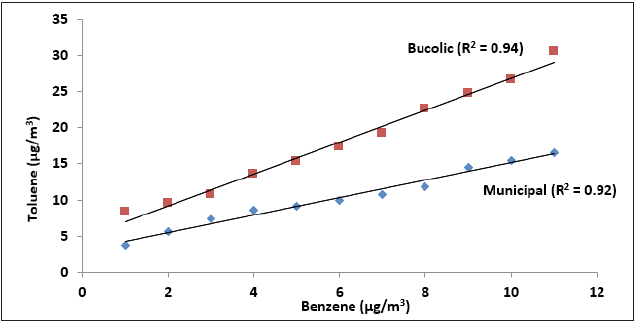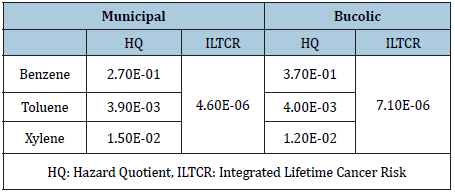- Submissions

Full Text
Environmental Analysis & Ecology Studies
Health Risks of Ambient BTX at Metropolitan and Bucolic Locations of Gorakhpur-A Terai Belt of India
Amit Masih* and Pandey JK
Environmental Research Lab, Department of Chemistry, India
*Corresponding author: Amit Masih, Environmental Research Lab, Department of Chemistry, India
Submission: January 24, 2020Published: December 21, 2020

ISSN 2578-0336 Volume7 Issue4
Abstract
Ambient air pollution is a major cause of various diseases which accounts for an estimated 4.2 million deaths per year globally. During the recent decade’s volatile organic compounds such as benzene, toluene, and xylene gained interest in the field of indoor and outdoor air quality. These are responsible for a numerous adverse health effects like asthma, dizziness, fatigue, eye, nose, and throat irritation. Thus, an investigation of ambient benzene, toluene, and xylene (BTX) was conducted at metropolitan (municipal) and bucolic sites of Gorakhpur for a span of one year to determine the contagion levels. Sampling and analysis of BTX were performed using a methodology based on NIOSH method 1501. BTX were sampled by drawing air through activated coconut shell charcoal tubes, using a low-flow SKC Model 220 sampling pump at the flow rate of 250ml/min for 20-24hrs. The air suction rate was verified every week using calibrated rotameters with an accuracy of ±1%. The samples were extracted with carbon disulphide by occasional agitation and the aromatic fraction was subjected to GC-FID. Total mean concentration of BTX was 32.19μg/m3 from all the samples and the total range was from 4.3μg/m3 to 54.7μg/m3 with the median of 26.3μg/m3. The maximum levels of total BTX were found to be 40.5μg/m3 in winters, followed by 29.6μg/m3 in summer and 26.3μg/m3 in monsoon season. The average BTX concentration was highest at bucolic site (19.1μg/m3) followed by municipal site (8.7μg/ m3). At both the sites, maximum B/T ratio was found in winter season whereas the X/B ratio was found to be lowest. Toluene against benzene plot shows R2 value of 0.92 and 0.94 at municipal and bucolic sites, respectively. At both the sites, the estimated integrated lifetime cancer risk (ILTCR) for benzene exceeded the threshold value of 1E-06 whereas the individual hazard quotients (HQ) for BTX did not exceed unity at any of the sites.
Keywords: BTX; Carcinogenic/Non-carcinogenic risk; Municipal and bucolic locations; Terai Belt
Abbreviations: HQ: Hazard Quotients; ILTCR: Integrated Life-Time Cancer Risk; VOC: Volatile Organic Compounds; RAIS: Risk Assessment Information System; HQ: Hazard Quotient; HI: Hazard Index.
Introduction
Volatile organic compounds (VOCs) such as benzene, toluene, and xylene (BTX) are among the aromatic compounds which are monocyclic, more volatile, and like each other in physical and chemical features. Because of their solubility and volatility, these compounds have the characteristics of diffusion and emission in the environment [1]. BTX mostly release to the atmosphere through vehicle exhaust, motor carburettor, refuelling evaporation in fuel petrochemical industries, automobile service stations and various combustion processes [2]. Its emission from the transportation sector is more than the half of total emissions, and gas stations are the second major source of emission [3]. BTX also plays an important role in the atmospheric chemistry. It has been recognized as an important photochemical precursor for tropospheric ozone and second organic aerosols [4]. Although the BTX can enter to the human body via congestion, skin absorption and breathing, the latter is the most important way of exposure. Human exposure to BTX can have serious health consequences such as neurological diseases or variety of cancers [5].
Benzene has been classified as group 1 carcinogenesis according to the international agency for research on cancer (IARC). Therefore, investigation of these unsafe compounds is becoming a crucial issue. Large number of studies has proved a strong association between occupational exposure to benzene by inhalation and an increased incidence of certain types of leukaemia [6]. Other adverse health effects of benzene include acute myelogenous leukaemia, blood diseases, plastic anaemia, injury of the immune system, menstruation disorders [7]. The main effect of toluene on human is on the central nervous system. Its exposure can cause tiredness, dizziness, faintness, memory loss, nausea, appetence decrease, hearing loss, and unconsciousness. Exposure to xylene may cause skin irritation, skin stimulation, dryness, skin rapture, blister, and skin dermatitis. Higher levels of xylene in atmosphere may cause unconsciousness and the death of individuals [8].
Benzene is emitted by vegetation and petroleum reservoirs [9]. USEPA have announced that the average annual standard of ambient air for benzene is 5 and 10μg/m3 respectively. However, because it is present in crude oil, natural gas, and unleaded gasoline, anthropogenic sources are the main contributors. Emissions from vehicle exhaust, evaporative loss, and incomplete fuel combustion processes are considered the main sources of benzene in outdoor air. Toluene and xylene are more abundant in gasoline than benzene and are also widely used in solvents. Therefore, outdoor levels of these compounds were expected to be higher than that of benzene. Even though their toxicity is lower than that of benzene, they have the same environmental fate and, when exposed to photochemical reactions in the atmosphere, produce compounds which can provoke adverse effects on human health. Thus, analysis of benzene, toluene, and xylene (BTX) levels in air is essential [5].
To our knowledge there has been shortage of BTX studies in India, even though BTX are classified as hazardous air pollutants. Therefore, it becomes more imperious to obtain the definite air quality factor for Indian cities. So, the monitoring of BTX in India has become more important because this country is in rising stage & in urban and rural areas, there is very close proximity of residence, busy road with elevated traffic and incineration activities is quite often. So, the aim of the present study is to determine the levels of gaseous pollutants, with focus on the exposure levels of ambient benzene, toluene, and xylene at municipal and bucolic locations of Gorakhpur, which is a terai region of northern India, to identify their prospective health effects.
Materials and Methods
Site description
Gorakhpur (26°46´N 83°22´E) is in the eastern part of the state of Uttar Pradesh in India, near the border with Nepal. It is located on the bank of river Rapti which is interconnected through many other small rivers. Gorakhpur city comes under the terai belt of eastern Uttar Pradesh, India. The present district of Gorakhpur, 265Kms east of capital Lucknow, on National Highway-28, Covers the geographical area of 3483.8 Sq. km having total population 10,61,428.
Sampling, extraction, and analysis
Air sampling was performed at municipal (Rapti Nagar) and bucolic site (Bhathat) simultaneously for a span of one year (Oct. 2015 to Nov. 2016). Monitoring was performed for 20-24hrs once a week in a scheduled manner and several 48 samples from each site and a total of 96 samples were collected from both the sites. BTX were sampled and analyzed using a methodology based on National Institute for Occupational Safety and Health (NIOSH) method 1501 [10-14]. BTX were sampled by drawing air through activated coconut shell charcoal tubes (CSC, 8mm x 110mm, 600mg) containing two sections of (main section 400mg, second section 200mg) separated by a 2mm urethane foam (SKC Inc.), using a low-flow SKC Model 220 sampling pump (SKC, USA) at the flow rate of 250ml/min for 20- 24hrs. The air suction rate was verified every week using calibrated rotameters with an accuracy of ±1%. Sampled air was then analyzed with an HP 6890 gas chromatography/mass spectrometer and gas chromatography/ flame ionization detector [10]. Charcoal beds in the sorbent tubes were transferred to 2ml vials and extracted by adding 1.0ml of carbon disulphide (CS2) with occasional agitation for 30min. Sampled air was then analyzed with an HP 6890 gas chromatography/mass spectrometer and gas chromatography/ flame ionization detector. The cold trap operating temperature was -30 °C and was raised to 250 °C for 3min. The carrier gas was nitrogen and an Agilent 19091J-413/E column (30m x 0.32mm i.d. x 0.25mm) was used. The column temperature was held at 40 °C for 5min, after which it was raised to 100 °C for 5min and then increased to 200 °C, at which it was held for 2min. For each compound, two ions (one target and one qualifier) were monitored. Compounds were identified based on their relative retention times and ion ratios. Identified compounds were quantified using internal calibration procedure, with five levels of calibration as follows: 0.1; 1; 5; 25; 100 μg/ml in CS2 in all solutions.
Result and Discussion
Exposure profiles of btx
The total mean concentration of BTX was 32.19μg/m3 for both the sites (municipal and bucolic) together at Gorakhpur. The average benzene, toluene and xylene concentrations were higher at the bucolic site having 13.3, 23.3 and 1.5μg/m3 while those at the municipal site were 8.4, 16.5 and 1.2μg/m3, respectively. Therefore, the mean total BTX concentration was also highest at bucolic site (19.1μg/m3) followed by municipal site (8.7μg/m3). This may be explained on the account of prevalent usage of cow-dung cakes, charcoal, wood etc. for cooking throughout the year. Additionally, in winter season stubble, brushwood and straw are also used for heating purpose. Concerning the BTX mass distribution between these two sites at Gorakhpur district, this study shows that toluene had the highest contribution followed by benzene at both the sites having 63% & 32% at municipal site and 61% & 34% at bucolic site, respectively. Toluene and benzene represent about 96% of the total BTX at both the sites. Toluene and xylenes are largely used as solvents and, therefore, their existence may come from sources other than traffic too. In addition, photochemical degradation of toluene and xylenes is faster than that of benzene [11-15].
Table 1: Average interspecies ratios (B/T and X/B) at municipal and bucolic sites.

Table 1 illustrates that at both the sites i.e., municipal and bucolic, maximum B/T ratio was found during winter season (0.64 and 0.75) followed by summer (0.32 and 0.41) and monsoon seasons (0.28 and 0.40) indicating that increase in concentration from monsoon to winter and summer to winter is maximum for benzene as compared to toluene and xylene. This fact is also supported by the X/B ratio which was found to be lowest in winter season (0.11 and 0.09) and increased during summer (0.18 and 0.11) and monsoon season (0.20 and 0.12) at municipal and bucolic sites, respectively.
Figure 1: Seasonal BTX concentrations (μgm-3) at municipal and bucolic sites.

The weather of Gorakhpur can be generally classified into three seasons, winter (November-February), summer (March-June) and monsoon (July-October). Figure 1 depicts the seasonal BTX pattern in ambient air at municipal as well as bucolic sites of Gorakhpur. At municipal site, the concentration of benzene in during winter, summer and monsoon seasons are in the order of 12.9, 6.6 and 5.7μg/m3 respectively, whereas toluene (19.6, 15.5 & 14.5μg/ m3), and xylene (1.5, 1.2 & 1.0μg/m3). At bucolic site the levels of benzene were 19.6, 10.8 & 9.6μg/m3 during winter, summer, and monsoon seasons, respectively.
Toluene and xylene concentrations were 25.6, 23.7 & 20.7μg/ m3 and 1.9, 1.5 & 1.2μg/m3 respectively. Although the trend of seasonal variation of BTX at both sites is similar with nature i.e., maximum concentration of BTX were found to be in winter followed by summer and monsoon seasons. The total BTX ratios for winter to summer (W/S) and winter to monsoon (W/M) were 1.4 & 1.5 and 1.5 & 1.6 at municipal and bucolic sites respectively indicating significant seasonal variations of BTX.
Figure 2: Correlation between Benzene and Toluene at both sites.

Figure 2 shows the plot of toluene against benzene with R2 value 0.92 and 0.94 at municipal and bucolic sites respectively, which suggests a linear relationship between toluene and benzene. Moreover, it also specifies that the source for benzene and toluene may be same i.e., the use of biomass fuel [4].
Health risk assessment
Benzene is classified as carcinogenic substance, while toluene, m, p-xylene, and o-xylene are classified as non-carcinogenic but hazardous to health substances. Thus, risk assessment has been performed regarding estimate the brunt of hazards on human health by these mono-aromatic pollutants [16]. In the current study, the non-cancer hazard and integrated lifetime cancer risk (ILTCR) due to the exposure to BTX at their prevailing levels were estimated [17]. The integrated lifetime cancer risk (ILTCR) was calculated from the equation:
ILTCR = EL (mg kg-1day-1) × CPF (mg kg-1day-1)
Where, EL is the effective lifetime exposure and CPF is the carcinogenic potency factor or cancer slope factor. The inhalation cancer slope factor of carcinogenic compounds for benzene was obtained from Risk Assessment Information System (RAIS) as 2.73 x 10-2 mg kg-1day-1(RAIS, 2010). A cancer risk of > 10-6 was considered “carcinogenic effect of concern;” a value ≤10-6 was considered an “acceptable level” [16]. Risk assessment for nonmalignant conditions was expressed by hazard quotient (HQ) defined as the ratio of yearly average daily concentration received (EY) and the reference concentration (RfC) calculated according to equation:HQ = EY/RfC
Where RfC - the inhalation reference concentration of the noncarcinogenic compounds toluene and xylene was obtained from the Integrated Risk Information System (IRIS) as 5 and 0.1mg/m3, respectively [18,19]. The RfC of benzene for non-cancer risk is 0.03 (ASTDR 2010). Summation of HQs for individual contaminants gave Hazard Index (HI).
Table 2: Estimate of non-cancer and cancer risk at municipal and bucolic sites.

Table 2 represents ILTCR and non-cancer (HQ) risks (for 15 years residing time for and individual). At both sites, the estimated cancer risk for benzene (4.6E-06) exceeded the threshold value of 1E-06 indicating more cancer risk from benzene due its high carcinogenicity. Benzene also gives the highest non-cancer HQ followed by xylene and toluene. The individual HQs for BTX did not exceed unity anywhere indicating no serious threat of chronic noncancer health effect in pollutant specific target organs for the city population [17,20-25].
Comparison of results with other studies
Table 3: Comparison of ambient BTX levels with other studies of world (μg/m3).

The present study was compared with the work done on BTX in Algiers, Egypt and Spain as illustrated in Table 3. According to the table, the BTX levels of the current study are below than the concentrations of BTX found either in Algiers, Egypt or in Spain, except of bucolic benzene levels which were found higher in the present study.
Acknowledgement
Financial support from Department of Science and Technology (DST), New Delhi, India in Project No. SR/FTP/ES-77/2013 is duly acknowledged. Authors gratefully acknowledge Revd. Prof. J. K. Lal (Principal) and Dr. S. D. Sharma (Head) Chemistry Department, St Andrew’s College, Gorakhpur, UP, India, for providing necessary facilities. Also thankful to Mr. Jay Patel, ERT, USEPA for providing technical support during the analysis of samples.
References
- Khoder MI (2007) Ambient levels of volatile organic compounds in the atmosphere of greater cairo. Atmospheric Environment 41(3): 554-566.
- Caselli M, Gennaro DG, Marzocca A, Trizio L, Tutino M (2010) Assessment of the impact of the vehicular traffic on btex concentration in ring roads in urban areas of bari (italy). Chemosphere 81(3): 306-311.
- Sergio MC, Graciela A, Monica RC, Katia MP (2012) The impact of BTEX emissions from gas stations into the atmosphere. Atmospheric Pollution Research 3(2): 163-169.
- Ruifang Fan, Junnan Li, Laiguo Chen, Zhencheng Xu, Dechun He, et al. (2014) Biomass fuels and coke plants are important sources of human exposure to polycyclic aromatic hydrocarbons, benzene, and toluene. Environmental Research 135: 1-8.
- Gallego E, Roca FX, Guardino X, Rosell MG (2008) Indoor and outdoor btx levels in barcelona city metropolitan area and catalan rural areas. Journal of Environmental Sciences 20(9): 1063-1069.
- Buczynska AJ, Krata A, Stranger M, Roekens E, Grieken RV (2009) Atmospheric BTEX-concentrations in an area with intensive street traffic. Atmospheric Environment 43(2): 311-318.
- Duarte DR, Courage C, Rushton L, Levy L (2001) Benzene in the environment: an assessment of the potential risks to the health of the population. J Occ Env Med 58: 2-13.
- ADE (2003) Department of the Environment, BTEX Personal Exposure Monitoring in Four Australian Cities Technical Report No b Appendcces.
- CONCAWE (Conservation of Clean Air and Water in Europe) (1997) Exposure Profile: Gasoline. European Oil Companies’ Organization for Environmental and Health Protection, Belgium.
- NIOSH (1994) Pocket guide to chemical hazards. NIOSH publications, USA.
- Bureau of Indian Standard (BIS): 5182. (2006) Methods for Measurement of Air Pollution. India.
- Masih A, Lall AS, Taneja A, Singhvi R (2016) Inhalation exposure and related health risks of btex in ambient air at different microenvironments of a terai zone in north india. Atmospheric Environment 147: 55-66.
- Masih A, Lall AS, Taneja A, Singhvi R (2017) Exposure profiles, seasonal variation and health risk assessment of btex in indoor air of homes at different microenvironments of a terai province of northern india. Chemosphere 176: 8-17.
- Masih A, Lall AS, Taneja A, Singhvi R (2018) Exposure profiles and health risk assessment of ambient btx at urban and rural environments of a terai region of northern india. Environ Pollut 242(Pt B): 1678-1683.
- Kerchich Y, Kerbachi R (2012) Measurement of btex levels at urban and semirural areas of algiers city using passive air samplers. J Air Waste Manag Assoc 62(12): 1370-1379.
- Zhang Y, Mu Y, Liu J, Mellouki A (2012) Levels, sources, and health risks of carbonyls and btex in the ambient air of beijing, china. J Environ Sci (China) 24(1): 124-130.
- Majumdar D, Mukherje AK, Sen S (2011) BTEX in an Ambient air of Metropolitan city. J Env Prot 2(1): 11-20.
- USEPA (2005) Toxicological review of toluene: In support of summary information on Integrated risk information system (IRIS).
- USEPA (2003) Toxicological review of xylene: In support of summary information on Integrated risk information system (IRIS).
- ATSDR (2010) Toxicological profile for benzene. USA.
- Finlayson PBJ, Pitts JN (1993) Atmospheric chemistry of tropospheric ozone formation: scientific and regulatory implications. Journal of Air and Waste Management Association 43(8): 1091-1100.
- Kerbachia R, Boughedaouib M, Bounouac L, Keddam M (2006) Ambient air pollution by aromatic hydrocarbons in Algiers. Atmospheric Environment 40(21): 3995-4003.
- Madhoun WAA, Ahmad SY, Noor FFMY, Nurul AG, Nurulilyana S (2011) Levels of benzene concentrations emitted from motor vehicles in various sites in Nibong Tebal, Malaysia. Air Qual Atmos Health 4: 103-109.
- Marc M, Jacek N, Bożena Z (2014) BTEX concentration levels in urban air in the area of the tri-city agglomeration (gdansk, gdynia, sopot), poland. Air Qual Atmos Health 7(4): 489-504.
- RAIS (2010) Toxicity profile.
© 2020 Amit Masih. This is an open access article distributed under the terms of the Creative Commons Attribution License , which permits unrestricted use, distribution, and build upon your work non-commercially.
 a Creative Commons Attribution 4.0 International License. Based on a work at www.crimsonpublishers.com.
Best viewed in
a Creative Commons Attribution 4.0 International License. Based on a work at www.crimsonpublishers.com.
Best viewed in 







.jpg)






























 Editorial Board Registrations
Editorial Board Registrations Submit your Article
Submit your Article Refer a Friend
Refer a Friend Advertise With Us
Advertise With Us
.jpg)






.jpg)














.bmp)
.jpg)
.png)
.jpg)










.jpg)






.png)

.png)



.png)






